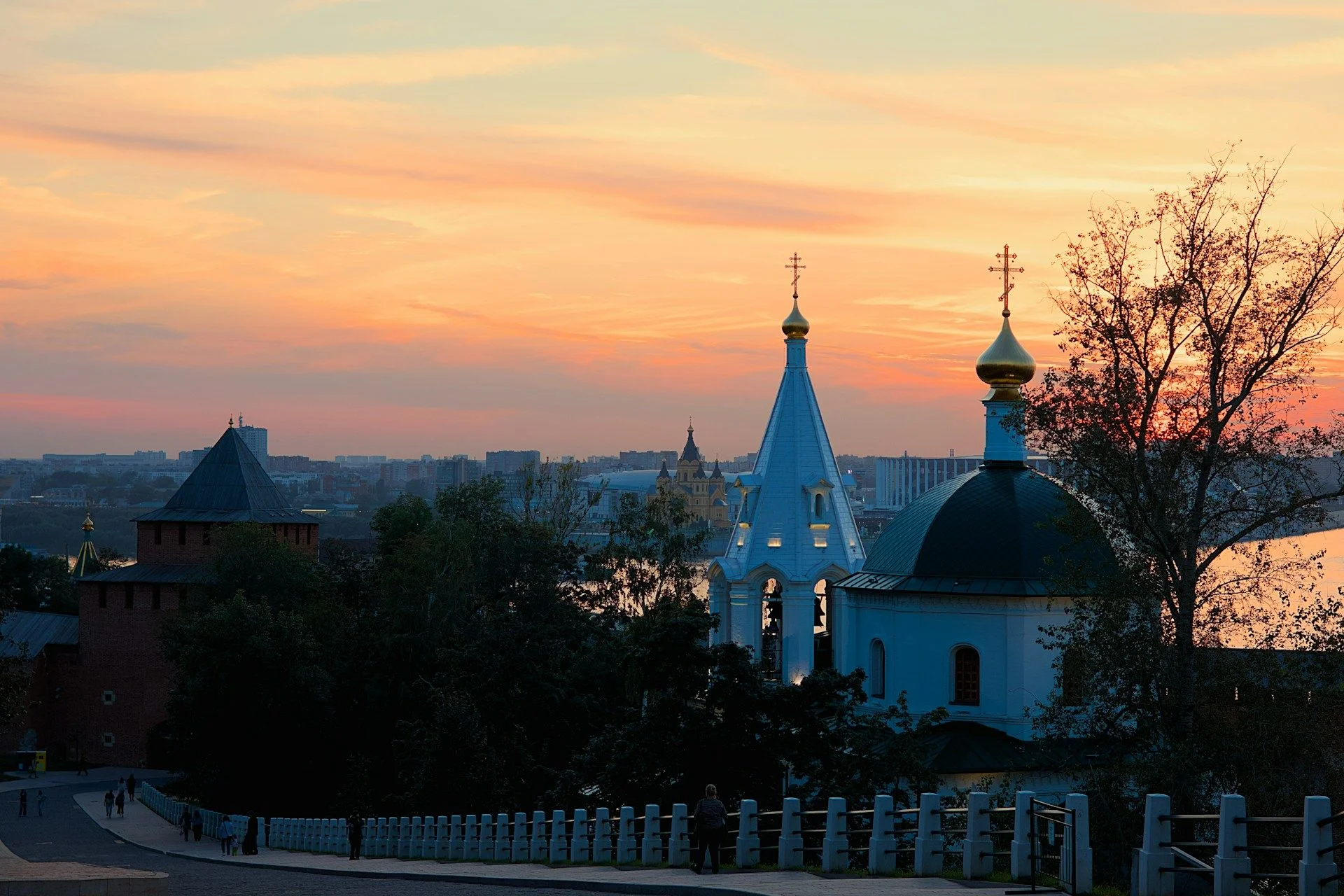Journey Through Nizhny Novgorod: Sightseeing Tips & Local InsightsHistoric riverside fortress meetsvibrant creative districts.

Advantages of traveling
to Russia
Where two great rivers converge
Nizhny Novgorod rises above the Volga and Oka — offering panoramic views and historic waterways.
Centuries of trade, defense, and culture
From the red-brick Kremlin to Art Nouveau mansions, the city showcases Russian evolution in architecture and purpose.
New energy in old quarters
Loft spaces, galleries, and festivals now fill once-industrial zones — turning the past into a vibrant urban present.
Where two great rivers converge
Nizhny Novgorod rises above the Volga and Oka — offering panoramic views and historic waterways.
Centuries of trade, defense, and culture
From the red-brick Kremlin to Art Nouveau mansions, the city showcases Russian evolution in architecture and purpose.
New energy in old quarters
Loft spaces, galleries, and festivals now fill once-industrial zones — turning the past into a vibrant urban present.

Useful articles
and recommendations from experts
Tourism in Nizhny Novgorod: Russia’s Riverside Gem of History and Creativity
Why Nizhny Novgorod Is a Rising Star for Travelers
Once a closed Soviet city and now a flourishing cultural hub, Nizhny Novgorod (formerly Gorky) is one of Russia’s most underrated travel destinations. Overlooking the confluence of the Volga and Oka Rivers, this historic city offers fortress views, merchant mansions, vibrant street art, and a fast-growing creative economy. Tourism in Nizhny Novgorod invites visitors to discover a place where past and future meet in striking ways.
As the fifth-largest city in Russia and an important transport and industrial center, Nizhny is well-connected yet pleasantly compact. It balances authenticity with modernity — a stronghold of Russian identity that now pulses with design, festivals, and youth energy.
Nizhny Novgorod Kremlin and Old Town Charm
The centerpiece of the city is the Nizhny Novgorod Kremlin, a 16th-century red-brick fortress perched on a high bluff above the Volga. Its well-preserved walls, 13 towers, and internal cathedrals offer panoramic views and a clear sense of historic significance. Inside, visitors can explore the Archangel Cathedral, museums, monuments, and walking trails.
Just beyond the Kremlin lies Bolshaya Pokrovskaya Street, a pedestrian avenue lined with imperial architecture, boutiques, cafes, and street performers. This “Arbat of Nizhny” connects major squares and offers a relaxed introduction to the city’s rhythm and style.
Historic quarters like Rozhdestvenskaya Street and Ilinskaya Sloboda reveal pre-revolutionary charm through pastel facades, merchant houses, and Orthodox churches — giving the city a distinct Central Russian atmosphere.
Volga Views and Riverfront Life
Tourism in Nizhny Novgorod is strongly tied to its geography. The city’s dramatic terrain — rising above two major rivers — creates natural viewpoints, embankments, and stairways that lead to sweeping landscapes.
The Chkalov Stairs, with 560 steps, descend from the Kremlin to the Volga, connecting historic and waterfront districts. The Nizhne-Volzhskaya Embankment is ideal for sunset walks, boat tours, and summertime events.
In warmer months, river cruises connect Nizhny Novgorod with other Volga cities like Kazan, Samara, and Yaroslavl — offering a slow-travel way to experience the region’s heritage and landscapes.
Religious and Architectural Heritage
Nizhny Novgorod’s skyline includes onion domes, bell towers, and churches that span centuries. The Church of the Nativity of the Blessed Virgin Mary (also called Stroganov Church) is a baroque masterpiece funded by merchant patrons.
The Alexander Nevsky Cathedral, built in the late 19th century, sits close to the waterfront and is one of the tallest Orthodox churches in Russia. Other highlights include Annunciation Monastery and Pechersky Ascension Monastery, both offering serene courtyards and distant city views.
Beyond religious landmarks, the city’s architecture includes Art Nouveau mansions, Soviet constructivist blocks, and wooden houses in quiet neighborhoods. It’s a place where architectural layers reflect Russia’s evolving identity.
Creative Industries and Urban Regeneration
Nizhny Novgorod is undergoing a renaissance. Former factory districts have been transformed into cultural spaces, event halls, and tech incubators. The ARTKvartal is a prime example — a cluster of galleries, loft cafes, artisan shops, and coworking venues built into pre-revolutionary warehouses.
The city hosts annual festivals including “Archstoyanie Urban”, “Seasons” design fair, and international jazz and film events. Street art projects, open-air theater, and youth collectives are now part of the cityscape — drawing parallels with cities like Kazan or Yekaterinburg.
This blend of industrial heritage and modern experimentation makes Nizhny Novgorod a magnet for young travelers, creatives, and cultural tourists.
Gastronomy and Local Flavors
Local cuisine in Nizhny Novgorod blends Volga river fish, hearty Russian fare, and artisan reinterpretations. Dishes like ukha (fish soup), pelmeni with wild herbs, and pirozhki with berries or cabbage can be found at both traditional taverns and modern bistros.
Strelka Street and Bolshaya Pokrovskaya are lined with gastropubs, coffee houses, and craft bakeries. Weekend markets offer local cheeses, honey, smoked fish, and herbal teas — perfect for edible souvenirs.
Vegan cafes, international cuisine, and experimental kitchens have also found a place, especially in the creative districts. This variety makes eating in Nizhny both grounded in heritage and open to innovation.
Logistics and When to Visit
Nizhny Novgorod is well connected by air, rail, and river. It lies around 400 km east of Moscow and can be reached in under four hours by high-speed train (Strizh). The local Strigino Airport (GOJ) offers domestic and seasonal international flights.
Public transportation is straightforward — buses, trams, and a small metro system. The city is compact enough for walking, and its hilly landscape makes for scenic exploration. Cable cars across the Oka River provide a unique commuting and viewing experience.
The best seasons to visit are:
- Late spring (May–June): Blossoming parks and river cruises resume.
- Autumn (September): Golden domes in fall colors and cultural festivals.
- Winter (December–January): Festive lights, snow-covered churches, and skating along the Volga.
Who Visits and Why
Nizhny Novgorod attracts:
- History lovers — fascinated by its military, trade, and religious past.
- River cruise tourists — stopping between Moscow and Kazan.
- Architecture enthusiasts — exploring wooden houses, Soviet design, and merchant estates.
- Young creatives — engaging with ARTKvartal and digital festivals.
- Domestic travelers — seeking weekend escapes with culture and comfort.
Its growing reputation as a “rediscovered classic” makes Nizhny Novgorod ideal for curious visitors looking beyond mainstream routes.
Discover Nizhny Novgorod with VelesClub Int.
VelesClub Int. offers curated travel experiences in Nizhny Novgorod — from guided Kremlin walks and boat tours to art-focused itineraries and real estate insights. Whether you’re visiting for culture, business, or relocation, our team connects you with trusted partners and local expertise.
Experience Nizhny Novgorod as more than a stop — let it be your window into the dynamic past and forward-thinking future of central Russia.
